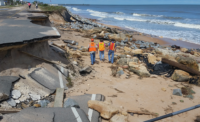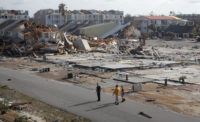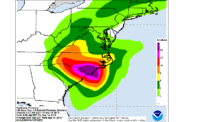In the wake of Hurricane Matthew’s assault on the East Coast, floods continue to isolate large portions of eastern North Carolina. Hundreds of roads and bridges remained submerged more than a week after the storm, which forced evacuations of thousands and killed 26 people in the U.S. Most were trapped inside their vehicles by floodwaters.
The lingering floods are reminiscent of those following Hurricane Floyd in 1999, when a similar storm pattern drowned the region, and last year’s “1,000-year storm” that blew out dams and wrecked highway infrastructure in South Carolina. The slow drain down raises the question of whether the lingering floods might be signs of sea-level rise and climate change.
Todd Hamill, a hydrologist for the National Weather Service’s Southeast Regional Forecast Center, doesn’t think so. He says the apparent increase in multi-punch storm events is largely coincidence, due in part to eastern North Carolina’s proximity to tropical weather patterns.
“If conditions are right for a hurricane or a tropical storm, the area will get a lot of rain,” Hamill says. “Once it falls, it has to find someplace to go.”
Hamill adds that this pattern is well documented and that any shifting atmospheric characteristics are occurring incrementally. “If you’d had a storm like this 30 years ago, you would’ve had the same issues,” Hamill claims.
But Ray Toll, director of coastal resilience research at Old Dominion University in Norfolk, Va., isn’t so sure. He points to data from a tide gauge near the Norfolk Naval Station that shows a 14.5-in. rise in the area’s sea level since 1930.
“We can also document the water and atmosphere are warmer each year and that the tropical behavior, in general, seems to be responding to both,” Toll says. “Having storms like Sandy and Matthew come up from the Deep South and maintain incredible intensities over such a long distance is a disturbing trend.”
Toll says another slower but, nevertheless, important influence on the region’s natural rainfall-handling capacity is subsidence, resulting from underlying geomorphology and decades of groundwater extractions.
“We do have ground measurements indicating land subsidence, but this is a very slow process and less likely to instill any sense of urgency,” Toll says.
The Rains
North Carolina’s flood woes are the worst since 1999, when Hurricane Floyd arrived on the heels of Hurricane Dennis, which already had saturated the area with more than 10 in. of rain. A similar pattern occurred with Matthew, as it was preceded in late August by Tropical Storm Hermine and by mid-September’s Tropical Storm Julia. Both tropical systems tracked along the southeastern coast of the U.S., spreading heavy rain from Georgia to Hampton Roads, Va.
During Oct. 8-9, the gradually weakening Matthew dumped as much as 20 in. of rain on eastern North Carolina, swelling streams and rivers that had just begun to recede from the preceding storms.
According to the NWS, the Neuse River crested in the town of Kinston on Oct. 14, reaching 28.31 ft—more than 7 ft above the location’s major flood stage. State emergency management officials expect that the Neuse and other major rivers could remain above flood stage for at least another week.
South Carolina’s 2015 storm was likewise influenced by the offshore presence of Hurricane Joaquin, which also led some to wonder if changing climate conditions are increasing the region’s vulnerability to major storms and flooding.
Hurricane Matthew is blamed for at least 25 dam failures in South Carolina’s Pee Dee River drainage area, raising concerns about the state’s underfunded dam safety program and, earlier this year, leading to a $595,000 funding increase. However, state legislators are resisting efforts to strengthen dam safety laws, voicing concerns about dam owners’ ability to afford improvements that might be required with more frequent inspections.
The Response
The U.S. Dept. of Transportation on Oct. 12 released $5 million in emergency highway aid to North Carolina for flood-damage repairs. Gregory Nadeau, head of the Federal Highway Administration, called it “quick release” funding aimed at near-term repairs, “which can make long-term repair work possible in the weeks ahead.”
Transportation Secretary Anthony Foxx said the aid is “just a down payment on the department’s commitment to reconnect people with vital services they need to begin the process of putting their lives back together.”
Meanwhile, in the northeast corner of North Carolina, PCL Civil Constructors still is working not only to recover two 140-ft-long barges that were ripped away from an anchorage by Matthew’s 80-mph gusts but also to restore its materials chain, which has been disrupted by the floods.
The barges are part of an equipment fleet being used to build a $216-million replacement for the Herbert C. Bonner Bridge at Oregon Inlet.
Pablo Hernandez, district engineer for NCDOT, says PCL “did a very good job of securing the site for the storm.” Marine equipment went to a predetermined safe-harbor mooring in the Pamlico Sound, about eight miles to the southwest, where the barges were rafted with other equipment, he says, adding that he can only speculate on how they got away. The two barges beached 23 miles and 26.5 miles, respectively, to the south, near Avon, N.C., one to three miles from deep water. Salvage efforts were set to start Oct. 18.










